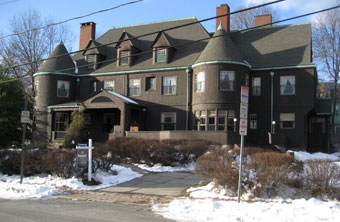An actual mansion on the hill, only $4.9 million

The 122-year-old house at 37 Lancaster St., Cambridge, is listed to sell for $4.9 million. That’s roughly a half-million dollars per fireplace. (Photo: Rich Lingner)
If you’re looking for a place to live, there’s a good opportunity on Lancaster Street, in the Avon Hill neighborhood. But reader Rich Lingner offers a warning: It’s a little pricey.
The 7,752-square-foot, nine-bedroom, 10-fireplace single-family home lists for $4.9 million.
“It has always been one of my favorite houses in Cambridge,” Lingner said Tuesday. “I walk by it often, and just today noticed the for-sale sign out front.”
It’s one of the most beautiful and historically significant houses in Cambridge, Lingner said, and has been called — on Page 111 of the “Survey of Architectural History in Cambridge: Old Cambridge” — the finest surviving carriage house in the city.
“I’m not sure of its preservation status, but it seems it must have some sort of designation,” Lingner said of the 122-year-old mansion. “It would be a shame if it were sold and broken up into condos, but I suppose it’s unlikely in this economic climate that it will be bought by Historic New England or the Cambridge Historical Society.”
There’s a slide show, including several shots inside the elegant home, on the Hammond Residential site.


Another great thing about this house is that it’s just one block away from the Gallow’s Lot where all the executions for Middlesex County were conducted. From Lucius Paige’s 1877 “History of Cambridge”:
Until 1720, the “Commmon” extended to Linnaean Street, and included also a few acres, lying in a nearly square form, at the northwesterly corner of Linnaean Street and North Avenue. This extreme point of the Common was set apart as a “Place of Execution,” or “Gallows Lot,” as it was more familiarly called. And after the Common was reduced to its present size, and the lots in this square fronting on the streets, had been granted to individuals, about one acre in its extreme northwesterly corner was reserved for its former use, until trials, and imprisonments, and executions were transferred to East Cambridge. It was entered from North Avenue through a bridleway or passage, between Lancaster Place and Arlington Street, now called Stone Court.